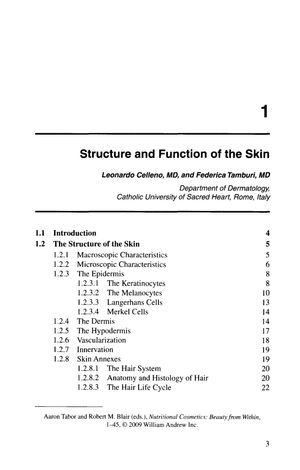Structure and Function of the Skin
January 2009
in “
Elsevier eBooks
”
epidermis dermis hypodermis keratinocytes melanocytes Langerhans cells Merkel cells hair hair follicles hair life cycle anagen catagen telogen alopecia sebaceous glands sweat glands sebum production eccrine glands apocrine glands keratinization skin repair barrier function vitamin D synthesis liposomes skin layers skin cells hair growth phases hair loss oil glands skin healing skin protection vitamin D production lipid vesicles

TLDR The skin has multiple layers and cells, serves as a protective barrier, helps regulate temperature, enables sensation, affects appearance, and is involved in vitamin D synthesis.
The document from 2009 provides a comprehensive examination of the skin's structure and function, detailing its layers (epidermis, dermis, hypodermis), specialized cells (keratinocytes, melanocytes, Langerhans cells, Merkel cells), and annexes (hair, nails, cutaneous glands). It describes the skin's protective barrier, immunological defense, thermoregulation, sensory functions, and its role in appearance and cosmetology. The hair system is explored, including the anatomy of hair follicles, the hair life cycle (anagen, catagen, telogen), and types of alopecia. The importance of sebaceous and sweat glands in skin health is discussed, with a focus on sebum production and the role of eccrine and apocrine glands in thermoregulation and odor production. The process of keratinization is outlined as essential for skin repair and barrier function, and the document also highlights the skin's absorption function, its role in vitamin D synthesis, and the use of liposomes in medicine and cosmetology. The document does not provide specific study sizes or direct conclusions.




